Introducing… Book Friends! A new feature of this year’s Guest of Honor weeks, where the Sirens team recommends books that would be friends with a guest of honor’s books. Today, we curate a list of titles we feel would complement the works of Anna-Marie McLemore, the author of The Weight of Feathers, When the Moon was Ours, Wild Beauty, and the upcoming Blanca & Roja. If you enjoyed her work, we hope you check out these other reads!

Sirens Guest of Honor Interview: Anna-Marie McLemore
We’re pleased to bring you the first in a series of candid, in-depth interviews with this year’s Sirens Guests of Honor. We’ll cover a variety of topics relevant to Sirens with each author, from their inspirations, influences, and craft, to the role of women in fantasy literature, and discuss our 2018 theme of reunion, as well as the themes of our previous four years: hauntings, rebels and revolutionaries, lovers, and women who work magic. We hope these conversations will be a prelude to the ones our attendees will be having in Beaver Creek this October! Today, Amy Tenbrink interviews our first guest of honor, Anna-Marie McLemore.
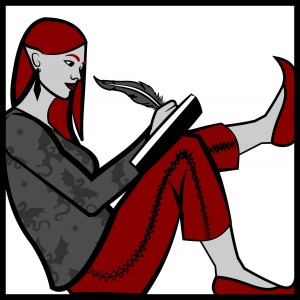
AMY: Your work is so often based on families: biological families sometimes, as with the feud between the Palomas and the Corbeaus in The Weight of Feathers, but just as profoundly, found families, such as Aracely’s mothering of water-tower-born Miel in When the Moon Was Ours or Estrella’s shocking discovery of Fel in La Pradera in Wild Beauty. Perhaps similarly, your work often addresses the legacies of those families, from the aforementioned feud to the Nomeolvides women’s immutable ties to La Pradera. Why is the idea of family so important to you, and by extension, your work?

ANNA-MARIE: I love that you include found family in this question, because that’s a concept that’s there for so many of us, especially in the LGBTQ+ community. For better or worse, family makes you. No matter your family’s size, no matter if they’re the ones you grew up with or the ones you found along the way.
Sometimes family is something you push against: Cluck and Lace from The Weight of Feathers will always carry their families with them, even as they realize that their own survival may depend on taking paths that lead away from them.
Sometimes family is something you find in the moment of becoming yourself: When Miel spills out of the water tower in When the Moon Was Ours, Aracely becomes someone who exists in the space between mother and big sister to her; at the same time, Aracely also becomes an older sister figure to Sam, the boy who finds Miel in the first place and who hangs the moon outside her window.
Sometimes family is made by common languages: Wild Beauty centers on five cousins who are not only Latina, not only blood-related, but also all queer. They know the strength of community and family. As curious as they may be about the strange boy who appears in the gardens, they wouldn’t make him part of their family if they couldn’t tell how much he respects that sense of community.
The family I grew up with and the family I’ve chosen both hold space in my life, and I think that ends up showing in my books. You’ll find that again in Blanca & Roja, a Latinx reimagining of “Snow-White & Rose-Red,” so it’s all about sisters, but it’s also all about the families we make.
(EDITOR’S NOTE: Blanca & Roja is due out in October.)
AMY: To me, the most profound, most present theme in your work is a trinity of acceptance, redemption, and forgiveness: Cluck’s saving Lace’s life, Miel’s love of Sam, the Nomeolvides’ welcome of Fel into their home. In your work, acceptance frequently creates a necessary foundation for redemption and forgiveness, and those are lessons that are important to a number of readers. What about those themes speak to you as a writer?
ANNA-MARIE: I think I often end up writing stories about how those around you can sometimes love you before you know how to love yourself, and how you do the same for them. Lace and Cluck in The Weight of Feathers recognize in each other the things that make them outcasts from their own families, and find those things beautiful in each other before they can in themselves. Miel and Sam in When the Moon Was Ours desperately want to show each other unconditional acceptance and love, but can’t until they feel safe acknowledging the ways in which their own hearts are broken. In Wild Beauty, Fel comes into the Nomeolvides family’s lives with a lot of humility, both for good reasons—he recognizes them as the queens of La Pradera—and for tragic ones—he carries a lot of free-floating shame without having any memory of what it’s attached to. They treat him as family in a way that reminds him of his own value, and he’s their reminder of the tremendous power they have as a community of Latina women.
In Blanca & Roja, acceptance becomes even more intertwined with the idea of redemption and forgiveness. In addition to being a reimagining of “Snow-White & Rose-Red,” Blanca & Roja is also a reimagining of Swan Lake, so in many ways it’s a story about the roles we get cast in—as women, as queer women, as women of color—and how we can write our own stories instead.
AMY: The first work of yours that I read was The Weight of Feathers, which you set in California’s Central Valley. I grew up in rural Michigan, and your Central Valley read to me as an almost sentient character full of that so-called American quiet desperation. Similarly, La Pradera, the magical garden in Wild Beauty, drives not only characters, but the plot, as the Nomeolvides women react to its apparent power and rage. How do you choose and create your settings?
ANNA-MARIE: The settings usually choose me, or, I should say, they choose my story. In The Weight of Feathers, the smaller towns of the Central Valley matched with the idea of the Palomas’ and Corbeaus’ traveling shows. Wild Beauty is so much about heritage and legacy and the terrifying truth that sometimes lives beneath that which is beautiful. So La Pradera, with its stunning gardens, enchanting magic, and bloody history (I won’t share more, because spoilers) became the perfect landscape for the story of the Nomeolvides women.
AMY: When the Moon Was Ours is a transcendent fairy tale, especially for readers who don’t often see themselves in such stories. Wild Beauty is both a story of magical women and incisive commentary about class and social struggle. Would you please share a bit about including and balancing both individual identity and societal themes within your work?
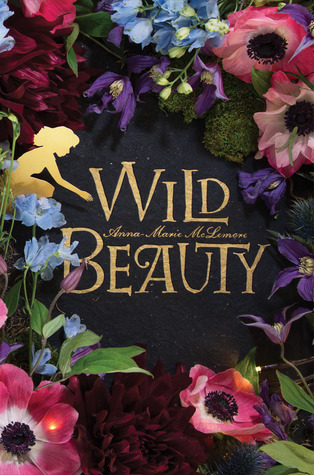
ANNA-MARIE: I love that you use the term fairy tale, because that’s really my heart as a writer. Even before I started writing fairy tale reimaginings like Blanca & Roja, it was my heart as a writer. My fairy tales are usually queer, brown, or both, because those are the communities I know. The fairy tales that are truest for me to write are ones grounded in identities I know.
In the process of taking myself seriously as a writer, there was an aspect of awakening, of realizing that my existence—as a Latina woman, as a queer woman, as a woman who loves a trans guy—that all of that was politicized, whether I wanted it to be or not. That it always had been. Leaving identity politics out of art isn’t a luxury I have, and knowing what I know about my own communities, it’s not one I want.
I want to write fairy tales for my communities. I want to write stories that are honest—in all their blood and history—and also hopeful—in placing LGBTQ+ characters and characters of color at their centers, in giving them space to claim the magic that belongs to them. A story about a Latina girl with roses growing from her wrist and a Pakistani-American trans boy who paints the moon cannot exist without acknowledging what it’s like for these characters to navigate their hometown. A story of five queer girls of color can be filled with enchanted gardens and ball gowns and still carry an understanding of the characters’ identities. I may not go around constantly thinking about being a queer Latina, but I never forget it completely, because the world never forgets, and because I have to choose, over and over, to be proud of it.
AMY: Your craft is, in a word, exquisite. Lyrical, poetic, honest, unforgettable. Would you please tell us about your writing process?
ANNA-MARIE: That’s so kind of you to say. In terms of writing process on a craft level, I sort of say everything at once and then pare back. I’ll describe something three ways, and then only one of those three ways will end up being the right one. So much of the magic in writing is letting your brain and your heart go wherever they want, and so much of the power of revising is in deletion, in pulling back, in distilling.
AMY: Sirens is about the remarkable, diverse women of fantasy literature. Would you please tell us about a woman—a family member, a friend, a reader, an author, an editor, even a character—who has changed your life?
ANNA-MARIE: My mother. If she were a fantasy character, she’d be the queen who’s equal parts brilliant and stylish, or she’d be the most glamorous of witches. I won’t say we always agree, but she’s so often been my model for finding power in being a woman and in being Latina.
Anna-Marie McLemore is the Mexican-American author of The Weight of Feathers, a 2016 William C. Morris YA Debut Award Finalist; 2017 Stonewall Honor Book When the Moon Was Ours, which was longlisted for the National Book Award in Young People’s Literature and won the 2016 James Tiptree, Jr. Award; and Wild Beauty, a fairy tale of queer Latina girls and enchanted, murderous gardens. Blanca & Roja, a magical realism reimagining of Snow-White & Rose-Red meets Swan Lake, is forthcoming in 2018.
Anna-Marie’s historical short stories are forthcoming in the anthologies All Out, The Radical Element: Twelve Stories of Daredevils, Debutantes & Other Dauntless Girls, and Toil and Trouble. Her shorter work has previously been featured in The Portland Review, CRATE Literary Magazine’s “cratelit,” and Camera Obscura’s Bridge the Gap Gallery, and by the Huntington-USC Institute on California and the West.
For more information about Anna-Marie, please visit her website or Twitter.

Book Club: The Prey of Gods by Nicky Drayden
Each year, Sirens chair Amy Tenbrink posts monthly reviews of new-to-her books from the annual Sirens reading list. You can find all of her Sirens Book Club reviews at the Sirens Goodreads Group. We invite you to read along and discuss!
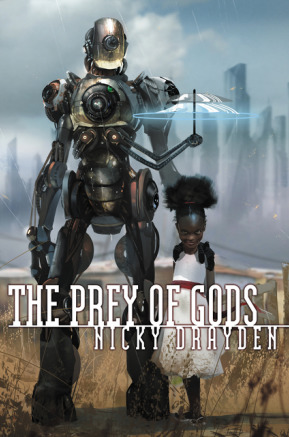
If you ask me, on any given day, which characteristics I admire in someone (but especially in a woman), ambition will always make my top three. I like people who dream big and bold and bright. I like people who think six impossible things before breakfast. I like people who try to change the world.
And what The Prey of Gods is, more than anything, is ambitious.
Nicky Drayden’s first novel is a science-fiction/fantasy mash-up, a living mythology, an AI fever dream, a breakneck romp to the brink of apocalypse that is also—improbably, shockingly—funny. Nicky Drayden dreamed big and bold and bright, y’all.
We’re in a near-future South Africa: Personal robots abound, the government has scaled renewable energy, genetic engineering is a coveted industry. Yet, vast class and identity striations still exist: Rural villages struggle with basic needs, those personal robots certainly aren’t a societal entitlement, and several of the characters struggle with acceptance of their sexuality or gender presentation. And beneath the surface roil surprising challenges: a new hallucinogen, a sentient AI uprising, and a living goddess who wants (what else?) to take over the world.
In many ways, The Prey of Gods is a smart, cleverly structured Scooby Gang book: a group of seemingly random people, meeting purportedly by happenstance, saves the world. The cleverness here is taking those seemingly random people, most of whom don’t know each other at the beginning of the book—and one, for heaven’s sake, that speaks only binary at the beginning of the book—and constructing a plot that brings these people, with their unique talents, together at the right time to save the world. Drayden will see your Buffy-style these-are-my-friends Scooby Gang and raise you a cast-of-strangers Scooby Gang.
Toward that end, The Prey of Gods features six—count ‘em, six—point-of-view characters of different races, different sexualities, different genders, and different classes.
- Muzi: a queer teenaged boy who can control minds and who is in (not-yet-confessed) love with his best friend
- Nomvula: a ten-year-old girl with impossible powers that she doesn’t know how to control, who destroys her entire village early in the book
- Wallace Stoker: a city councilman on the rise whose feminine alter ego is still secret
- Riya Natrajan: a world-famous pop star with issues of her own, not the least of which is her physical relationship with her drug dealer
- This Instance/Clever 4-1: a personal robot whose first thought is to worry about Muzi, and whose second thought is to worry about the fact that it’s worried
- Sydney: the current incarnation of an ancient demigoddess
The Prey of Gods also features 59—count ‘em, 59—chapters in only 377 pages.
Hang on, I’ll do the math for you: That averages out to 6.39 pages per chapter, and 62.83 pages per point-of-view character. And I’m deeply conflicted about those numbers.
On one hand, The Prey of Gods reads like an accelerant. Those short chapters, their cliffhanger endings, and the constantly shifting points of view combine to make this read very much like the world is on fire. The pacing lends a highly skilled immediacy to the book, especially as you see the pieces start to come together.
On the other hand, I usually struggle with multiple points-of-view books, and I found the sheer number of point-of-view characters in The Prey of Gods and the constantly shifting viewpoints to be a huge challenge as a reader. In the end, I didn’t end up identifying with or liking or wanting to know more about most of the point-of-view characters. (Though I liked the robot a lot. Like, a lot a lot.) And I’m trying to reconcile that with the fact that there are characters with whom I’ve spent fewer pages (say, in short stories) that I love and why, in a larger work, 62.83 pages was so wholly insufficient. (I also really liked the drug dealer and he’s hardly on the page!)
So where I come out is this: I greatly, deeply admire Drayden’s ambition. To envision a realistic world, set in the near future, that includes both sentient AI and a living mythology, and then to envision that world saved by an almost random group of often-marginalized people is an act born of tremendous ambition. The Prey of Gods is smart and funny and inclusive—and if you’re looking for someone doing something different and aspirational and clever in the speculative space, this is it. But I also found that the execution kept me, as a reader, too far removed from the characters themselves. In a world of sentient AI, the fact that I liked the robot far and away the most of anyone perhaps means that Drayden’s characters were not, in the end, quite human enough.
Amy Tenbrink spends her days handling strategic and intellectual property transactions as an executive vice president for a major media company. Her nights and weekends over the last twenty-five years have involved managing a wide variety of events, including theatrical productions, marching band shows, sporting events, and interdisciplinary conferences. Most recently, she has organized three Harry Potter conferences (The Witching Hour, in Salem, Massachusetts; Phoenix Rising, in the French Quarter of New Orleans; and Terminus, in downtown Chicago) and eight years of Sirens. Her experience includes all aspects of event planning, from logistics and marketing to legal consulting and budget management, and she holds degrees with honors from both the University of Southern California’s Thornton School of Music and the Georgetown University Law Center. She likes nothing so much as monster girls, Weasleys, and a well-planned revolution.

New Fantasy Books: June 2018
We’re excited to bring you a roundup of June 2018 fantasy book releases by and about women and nonbinary folk. Let us know what you’re looking forward to, or any titles that we’ve missed, in the comments!
As always, we’d love to hear from you. If you’ve sold a fantasy work, read a great recently-released story, discovered a fantastic link that we missed, or if you’ve got a book or story review to share, feel free to leave a comment below!


Where Are They Now: 2009 Guests of Honor
This fall will mark our tenth year of Sirens. With our conference theme of reunion, it’s the perfect chance to reflect on past conferences and revisit some old friends. In this series, we check in with our past Guests of Honor to see what they’ve been up to these days. If you attended Sirens that year, please share with us your memories of 2009 in the comments or on social media, and take a stroll with us down memory lane!
In 2009, our theme was warriors, and our inaugural Guests of Honor were Tamora Pierce, Kristin Cashore, and Sherwood Smith.
Tamora Pierce
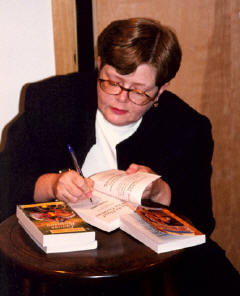
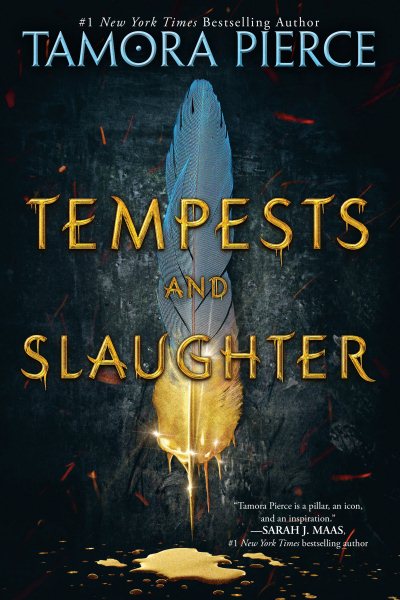
Tamora’s most recent publication is Tempests and Slaughter, the first book in the long-anticipated Numair Chronicles, which came out in February 2018. The series follows the early life of the Tortall Universe’s most powerful mage, Arram Draper, in his early days as a student, before he grows into Numair Salmalin and partner of wildmage Veralidaine Sarrarsri. Tempests and Slaughter hit #1 on the New York Times bestseller list and Tamora completed a multi-city book tour a few months ago—you can read her recap post here.
For longtime fans of the Tortall Universe, Tortall: A Spy’s Guide, a full-color, behind-the-scenes collectible guide, came out in October 2017.
Where She Is Now: Hard at work on the second book of the Numair series, for which three books are planned. “She has some ideas for her next series—and there will be a next series!—but for the time being, there are no other projects planned and scheduled after the Numair Chronicles.”
Upcoming Public Appearances: Guest at Denver Comic-Con 2018
Kristin Cashore
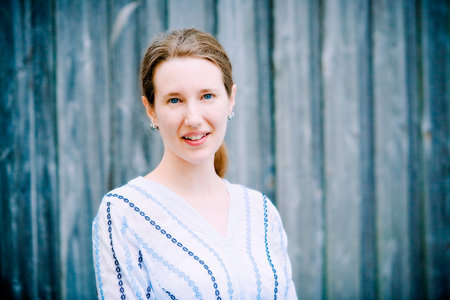
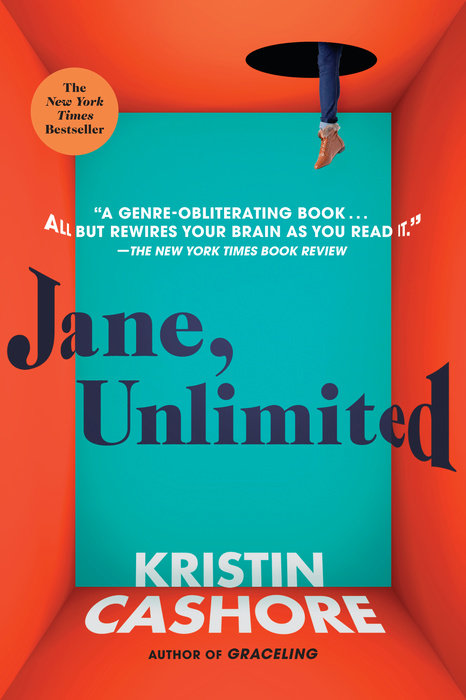
Kristin’s latest book, Jane, Unlimited, came out in September 2017 to awe, acclaim, and brain-twisting. Described as “a kaleidoscopic novel about grief, adventure, storytelling, and finding yourself in a world of seemingly infinite choices,” Jane, Unlimited made the list of the Young Adult Library Services Association’s (YALSA) 2018 Best Fiction for Young Adults, was an Indie Next Top Ten Pick, and hit both the New York Times Bestseller List and the Indiebound Bestseller List.
Jane, Unlimited’s newly re-jacketed paperback will come out on July 10, 2018.
Where She Is Now: Releasing a tenth anniversary edition of Graceling this September. In October, she’s going to be sailing on a tall ship in the Arctic Circle with other artists: “It’s a two-week artist residency organized by an organization called The Arctic Circle which sends artists into that vulnerable environment in the hopes that it will influence their art, which will then influence consumers to are about saving the environment.”
Sherwood Smith
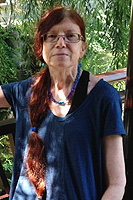
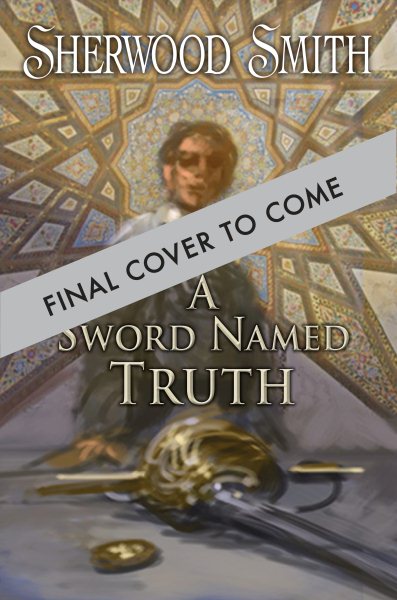
After a few postponements, Sherwood’s first book in a new series, A Sword Named Truth, has a tentative release date of December 8, 2018. For longtime fans of Sartorias-deles, the world in which the Inda and Crown Duel books are set (as well as Banner of the Damned), this series marks a major new arc, in which “young rulers must cooperate to protect their world from the magical threat of the mysterious kingdom of Norsunder.”
Also, Traitor, the fourth and last of The Change series co-written with Rachel Manija Brown, will come out this year.
For fans of Sherwood’s Wren series, you’ll be pleased to discover that an omnibus edition (including the long-awaited Wren Journeymage) is available as an ebook.
Where She Is Now: Planning to independently publish The Time of Daughters, set 100 years after Inda, this summer. It deals with “the long shadow cast by Inda & Co. And power. And gender.”
Upcoming Public Appearances: Instructor at Viable Paradise 2018

Read Along with Faye: Food of the Gods by Cassandra Khaw
Each year, Communications Director Faye Bi attempts to read the requisite 25 books to complete the Sirens Reading Challenge. In 2018, a Reunion year, she’ll be reading books from the past four years’ themes: hauntings, revolutionaries, lovers, and women who work magic. Light spoilers ahead. If you’d like some structure—or company—on your own reading goals, we invite you to read along!
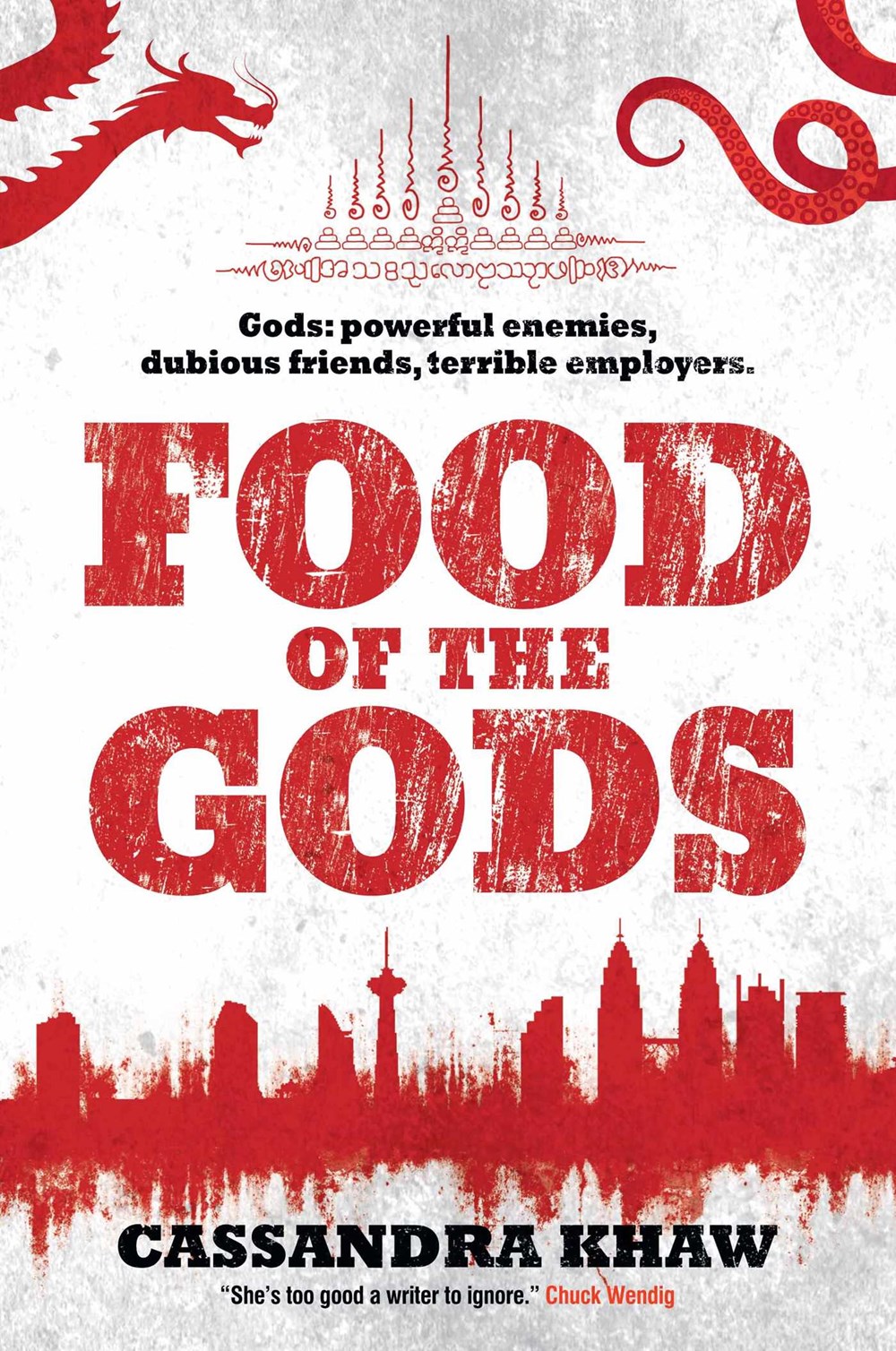
Going into Food of the Gods, I knew absolutely nothing except that Amy Tenbrink said this was her favorite book of 2017. Amy and I are book friends most of the time, so I knew I would pick this up eventually… and I now know so much about her in why she loves this book.
Rupert Wong is a cannibal chef for the gods by day, and a pencil pusher for the Diyu (the Ten Chinese Hells) by night. He does this to work off his karmic debt, having done some very bad things in his life so far, in the hopes that by the time he actually dies, his soul might not be condemned to eternal damnation slash Even Worse Things. And Rupert, bless him, is supremely talented as a chef, and also supremely witty as an employee, so much so that he’s (dare I say) kept around for both his skills and entertainment for the benefit of his divine employers.
But first, an aside: wow, I wasn’t sure how to feel while reading Food of the Gods. It’s obvious that Cassandra Khaw loves food as much as I do, but Rupert is literally preparing flesh—a deceased adult film actress features in a memorable scene—as he slices, dices, spices, reduces, seasons, smokes, and otherwise prepares feasts for his deific masters. I didn’t know whether to feel revolted or hungry, because Khaw does not hold back on the exceedingly gruesome detail, but all that flesh simmering in a curry, hmm… “Human is very similar to pork, after all.”
What Khaw also does fabulously is her modern, occasionally fourth-wall breaking mythology. It’s the cooler, hipper version of Neil Gaiman’s American Gods with a similar idea of the gods of different faiths being at war with one another, but with way more panache and way less pretentiousness. (The modern gods include a YouTube cat.) I didn’t know that Food of the Gods was a combination of two novellas, but after the fact, it makes sense that I’ve read two separate Rupert adventures that have two different, episodic plots.
Rupert Wong, Cannibal Chef takes place mostly in Kuala Lumpur in the first half, where Rupert has to solve the mystery of who murdered the ocean god Ao Qin’s daughter—with a cast of ghouls, gods, spirits and divine beings you don’t normally see in fantasy (Rupert convincing a legion of kwee kwia spirits not to unionize is the funniest). This is followed by the most hilarious plane ride—those with annoying flight companions will relish Rupert’s revenge on a snotty teenager—and then Rupert Wong and the Ends of the Earth, which is set in London where the Greek pantheon has set up shop. There, Rupert is on loan for his cooking skills, but finds himself in the middle of a Sisyphean gambling ring and the family drama the Greek gods are well-known for.
As a reader who prefers less commonly-explored settings in urban fantasy, I preferred the first installment, but I appreciated Khaw’s lens of showing us London through Rupert’s eyes—he absolutely doesn’t understand how these Greek gods can be so callous and uncivilized. Some of the plot was lost on me, as I found myself distracted by witty zingers and descriptions of food and cooking. But the writing is so delightful, and Rupert, despite being a genuinely selfish asshole, still tries to do the right thing and often does, even for the “wrong” reasons (wanting to be a better person for your lady friend is not that bad, Rupert!). And even though Rupert’s the main character, most of his good deeds involve helping women do what they need to do on their own terms. It nearly kills him to take a compliment from Demeter, who tells him that he is a good person.
Will you like Food of the Gods? I don’t know, but I did. It’s truly absurd. It’s most definitely unique. (It’s not an easy read, especially if you’re reading a print copy and the page margins are smaller than average?) But if you love wordplay, clever mythology, copious descriptions of food, a plethora of witticisms and a bumbling, yet somehow endearing hero, you’ll overlook the out-of-left-field plot and enjoy the onslaught of detail. And most definitely, if you’re a lawyer, this is totally your jam. By the end of the novel, Rupert essentially gets his freedom through lawyering! And contracts! Two opposing gods with claims on his employment can’t decide which contract supersedes the other. Lulz.
Next month’s book: Her Body and Other Parties by Carmen Maria Machado
Faye Bi is a book-publishing professional based in New York City, and leads the Sirens communications team. She’s yet to read an immigrant story she hasn’t cried over, and is happiest planning nerdy parties, capping off a long run with brunch, and cycling along the East River.

Sirens Review Squad: Children of Blood and Bone by Tomi Adeyemi
The Sirens Review Squad is made up of Sirens volunteers, who submit short reviews of books (often fantasy literature by women authors) they’ve read and enjoyed. If you’re interested in sending us a review to run on the blog, please email us! Today, we welcome a review from Amanda Hudson on Tomi Adeyemi’s Children of Blood and Bone.
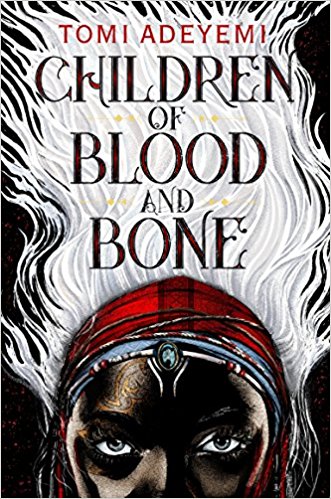
In her debut novel Children of Blood and Bone, Tomi Adeyemi blends African heritage into a vivid new fantasy world called Orïsha, where a merciless king has driven away magic. By his decree, divîners—those capable of controlling Orïsha’s magic—are systematically killed, leaving their families discriminated against and forced into hiding. Adeyemi expertly weaves the themes of prejudice and oppression into Zelie, her brother Tzain, and the princess Amari’s quest to restore magic to the divîners before it is erased from the Orïsha for good.
Adeyemi tells the story of this journey with three point-of-view characters, and in doing so, creates a page-turner that is hard to put down when a chapter ends. I either wanted to know what happened next, or I wanted to get back to a particular character’s perspective. The book begins with Zélie, who was forced to watch the monarchy kill her divîner mother, yet still teams up with a fleeing princess who possesses an artifact required to restore magic to their lands. That princess, Amari, is determined to do what she believes is right, even if it goes against her father’s wishes. Inan, Amari’s brother and the prince, is desperate to show his father that he is capable and worthy of one day becoming king. Alternating between Zélie, Amari, and Inan’s perspectives reveals the complexity of the world Adeyemi has created, and delves deeper into the ethical and political issues of the king’s tyrannical regime.
Adeyemi creates a beautifully rich world, with deeply-drawn characters and social structures to match. There are gentle reminders every so often that this world is not my own, such as the animal Zélie and her family rides. This is what I look for in great fantasy—a place I can relate to, but also new and different in intriguing ways. Adeyemi’s Orïsha feels spellbinding and alive.
I cannot think of a book that does not contain at least one trope, but occasionally, the unexpected use of a popular trope completely removes me from the page. Children of Blood and Bone, for all its wondrous worldbuilding, contains a trope I’ve come to abhor in YA fantasy: children forced to fight other children in a tournament or arena setting until only one is left alive, explicitly for the entertainment of adults. Perhaps the inclusion of this trope would have been less irksome if it had not been entirely unnecessary to the plot.
It wasn’t surprising to me, given the overall predictable quest structure of Children of Blood and Bone, that Amari, Zélie and Tzain would find their way to a town of laborers living in miserable conditions, and that the laborers would be forced into stockades and treated like animals. From the setup, I knew that Zélie would likely learn that the princess (and maybe the prince) are not like their ruthless father. I also suspected that Amari would realize the extent of the king’s horrific regime. I was there, I was engrossed. But, at the mention of an arena, I disconnected from the story for several chapters. I wish I could have removed these chapters altogether; this one aspect jolted me out of a powerful, enticing world, and forced me into a generic, worn-out trope. Suddenly, I was comparing this book to the last one I’d read featuring the same trope.
The plot progresses fairly quickly from there, but then I was nervous about what other contrived trope would be thrown my way. By the end, my only other complaint was that I foolishly had not realized that Children of Blood and Bone is the first of a series. At 525 pages, I was so sure it would be a standalone. I wish it were! I picked it up when it was recently released, with the second book far off in the future. Now I’m completely invested in the world, the characters and Adeyemi’s language; and I crave closure. The wait for book two begins.
Amanda Hudson works full time as a game developer in Malmö, Sweden. She holds a JD from Baylor University and previously practiced law in Texas. When not reading or writing fantasy, Amanda enjoys eating delicious Scandinavian foods and playing video games and board games.

Book Club: Miranda and Caliban by Jacqueline Carey
Each year, Sirens chair Amy Tenbrink posts monthly reviews of new-to-her books from the annual Sirens reading list. You can find all of her Sirens Book Club reviews at the Sirens Goodreads Group. We invite you to read along and discuss!
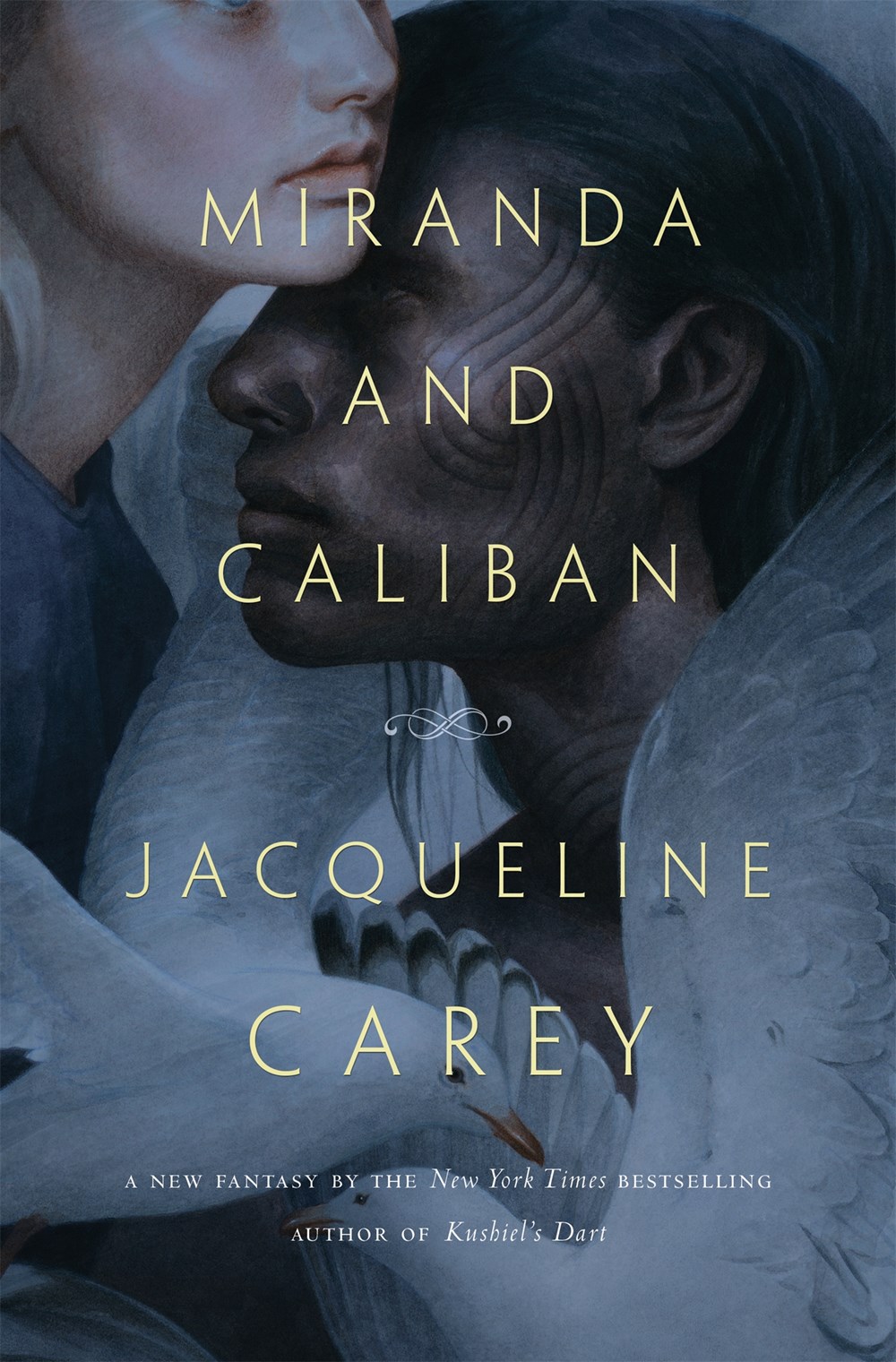
Are you familiar with The Tempest, Shakespeare’s storm-swept comedy full of revenge and magic?
I wasn’t.
While I will happily deconstruct prophecies and the self-fulfillment thereof in Macbeth for hours and I can still quote entire passages of Julius Caesar that I learned almost 30 years ago and I once dated a Hamlet for five long years of indecision, I have yet to meet a Shakespeare comedy that I like. This dates back to, of course, my first Shakespeare encounter in ninth-grade English: Romeo and Juliet, which you’re about to tell me is not a comedy, to which I will respond, “Only the parts that I loathe.” Bring on the death, please, and leave the purportedly funny coincidences out of it.
I still have not read The Tempest, incidentally, but the Internet was kind enough to tell me all about it: The white magician Prospero, inhabiting a deserted isle with his white daughter Miranda and a “savage” black boy named Caliban, who is the son of the dead witch Sycorax. Prospero contrives to bring those who exiled him to the isle, to be shipwrecked by a magical storm. Stuff happens, Miranda marries a prince of Naples, and all is well with the world.
Or something.
Jacqueline Carey’s Miranda and Caliban interrogates The Tempest, which one might presume, even from the brief summary above, is in need of a good interrogation. Miranda and Caliban opens several years after Prospero and Miranda’s exile to the isle: Miranda is a child of six or so, while orphaned Caliban is, at best guess, several years older. Very early in the book, Prospero works magic and compels Caliban to appear, only to lock him in a room in the hopes that confinement will impart refinement: language, posture, chamber pot usage, religion, and such. As you consider this, please remember that Prospero and Miranda are white, and Caliban is black.
Miranda’s gentle tutelage succeeds — for some value of “succeeds” — where Prospero’s aggression fails: Caliban learns their language and what is expected of him in this strange, new world ruled by an ill-tempered magician. Caliban eventually earns some measure of freedom — remember, though, that Prospero summoned him in the first instance, so “freedom” here is misleading notion — by supplying the name of the “evil” god that his mother worshipped. Prospero uses that name to free the wind spirit Ariel from a tree, only to bind him, too, to servitude.
As they age, Miranda and Caliban become friends, though it’s never clear if their friendship is born solely of their lack of options. Even after Ariel is freed from the tree, he’s mercurial, temperamental, and manipulative, not suitable for friendship for either Miranda or Caliban, and as you might expect from a volatile spirit in a Shakespeare play, in the end, Ariel’s impact on Miranda and Caliban’s friendship exceeds even their own. But Caliban remains Prospero’s servant, Miranda remains Prospero’s deliberately ignorant daughter, and Prospero’s plotting continues apace.
When Miranda blossoms, if you will, into a woman, Miranda and Caliban’s relationship changes. She menstruates for the first time, and thinks she’s dying. Her father gives her the world’s worst feminine hygiene contraption and collects her menstrual blood for his own magical purposes. (EW.) Caliban catches a glimpse of Miranda naked, and begins to understand the changes in his own body, only to be caught masturbating by Ariel, who calls him rude and savage, a monster. Miranda and Caliban attempt to consummate their relationship, only to be interrupted by an enraged Prospero, informed by a tattling Ariel.
Eventually, Prospero’s opportunity arises and Miranda and Caliban catches up with The Tempest: a magical storm, a shipwrecked boat, a betrothal, and Miranda sails away from the isle, leaving Caliban behind, but not without perhaps hollow promises to send for him when she’s a princess of Naples.
As I mentioned above, The Tempest is in need of a good interrogation. In the end, however, I found that Carey’s attempt was perhaps too gentle for me. I wanted more pointed criticism, more explicit condemnation of Prospero’s abuse and control of both Miranda and Caliban. I wanted some discussion of Sycorax other than, essentially, “the evil witch that used to live here, but she’s dead, and good riddance.” I don’t require a different, more thoughtful, more progressive ending, but I wanted a lot more deconstruction and complexity in getting there.
That said, I’ve been considering lately that simple truth-telling might be its own form of feminism. Sarah Pinborough’s Poison, for example, is a retelling of Snow White that (arguably) ends more poorly for Snow White than the fairytale itself. One might argue that that’s not feminist, simply because things go so badly for Snow White, but I find that that sort of truth-telling — here’s how things would actually go and they’re worse than you thought — is ultimately feminist.
While I might find the feminism in Miranda and Caliban less pointed than I would like, there is, at least, a form of truth-telling in it: Prospero’s use of his daughter for his own ends, Prospero and Ariel’s endless, on-page racism, Caliban’s enslavement. Explicitly marking these issues, if not addressing them fully, is perhaps its own form of feminism, even if it isn’t mine.
Amy Tenbrink spends her days handling strategic and intellectual property transactions as an executive vice president for a major media company. Her nights and weekends over the last twenty-five years have involved managing a wide variety of events, including theatrical productions, marching band shows, sporting events, and interdisciplinary conferences. Most recently, she has organized three Harry Potter conferences (The Witching Hour, in Salem, Massachusetts; Phoenix Rising, in the French Quarter of New Orleans; and Terminus, in downtown Chicago) and eight years of Sirens. Her experience includes all aspects of event planning, from logistics and marketing to legal consulting and budget management, and she holds degrees with honors from both the University of Southern California’s Thornton School of Music and the Georgetown University Law Center. She likes nothing so much as monster girls, Weasleys, and a well-planned revolution.

New Fantasy Books: May 2018
We’re excited to bring you a roundup of May 2018 fantasy book releases by and about women and nonbinary folk. Let us know what you’re looking forward to, or any titles that we’ve missed, in the comments!
As always, we’d love to hear from you. If you’ve sold a fantasy work, read a great recently-released story, discovered a fantastic link that we missed, or if you’ve got a book or story review to share, feel free to leave a comment below!























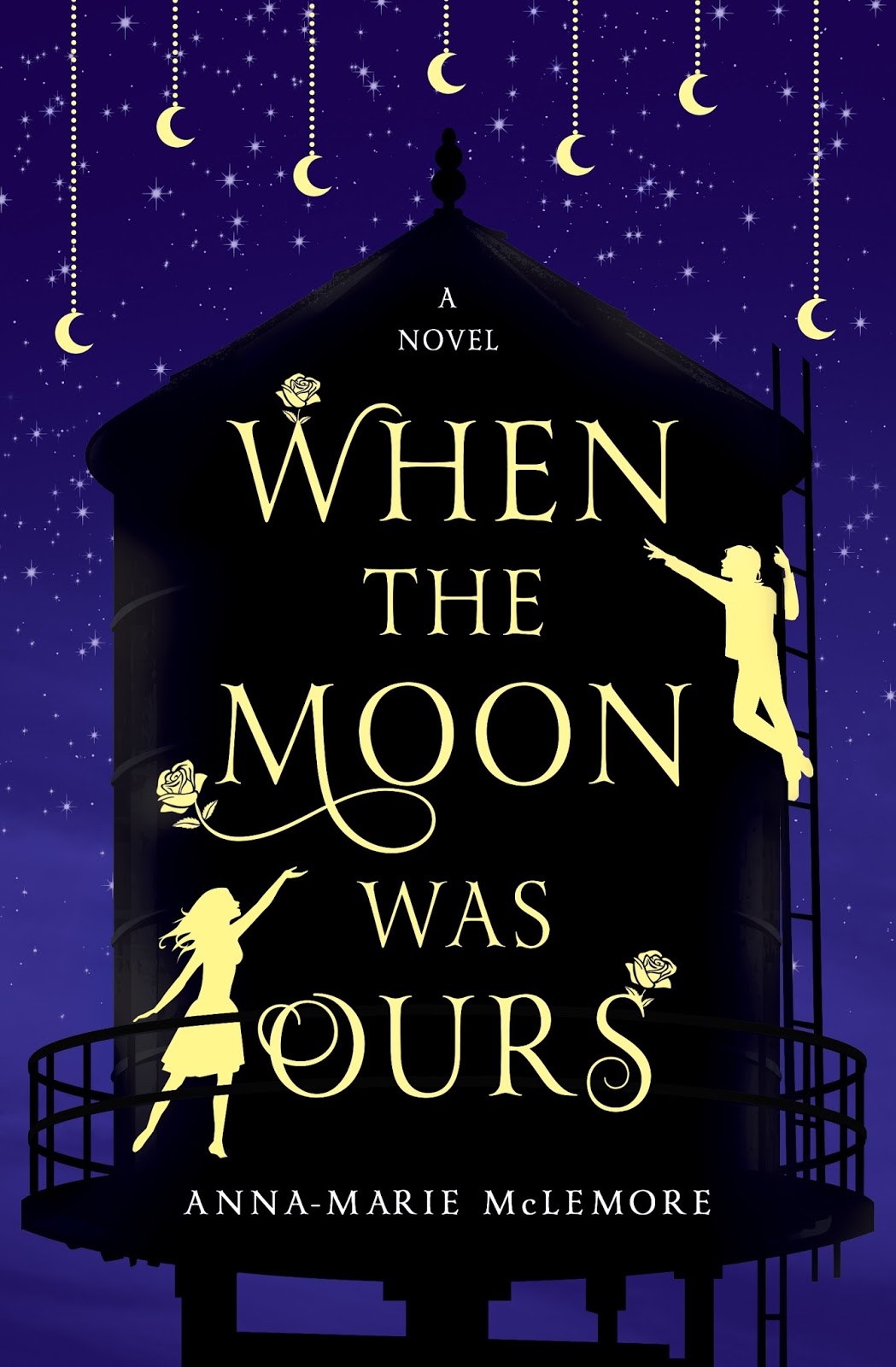
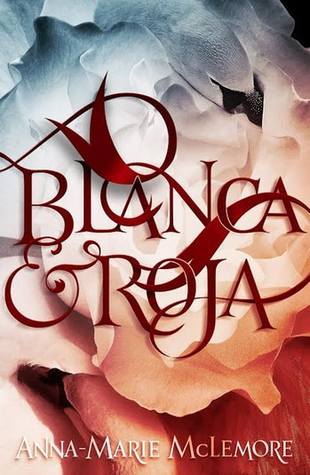



























































Connect with the Sirens community
Sign up for the Sirens newsletter